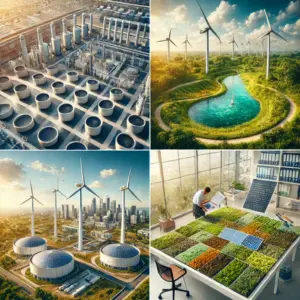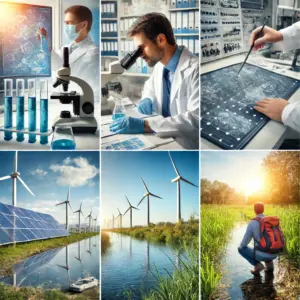Here you can download the Environmental Engineering II Notes – EE II VTU of as per VTU Syllabus. Below we have list all the links as per the modules.
Environmental Engineering II Notes – EE II VTU of Total Modules
Please find the download links of the Environmental Engineering II Notes – EE 2 VTU are listed below:

Environmental Engineering II Notes | PDF, Syllabus, Books | B Tech (2025)
Environmental Engineering II is a crucial subject for B. Tech students, especially those studying under the VTU (Visvesvaraya Technological University) syllabus. This subject delves into essential topics such as sanitation, sewerage systems, wastewater treatment, and effluent disposal, making it vital for students aiming to excel in the field of environmental engineering. The notes provided here are comprehensive and detailed, serving as an excellent resource for students.
Overview of EE II Notes Pdf
The Environmental Engineering II notes cover a wide range of topics essential for understanding and mastering the subject. These topics include the necessity for sanitation, methods of domestic wastewater disposal, design and materials for sewers, sewer appurtenances, wastewater characterization, and various methods for the treatment and disposal of wastewater. These notes are meticulously organized into units and modules to help students grasp the content effectively.
The Following Topics are Covered in Environmental Engineering II Handwritten Notes
- Introduction to Sanitation and Sewerage Systems
- Design and Material of Sewers
- Sewer Appurtenances and House Drainage
- Wastewater Characterization
- Disposal of Effluents
- Treatment of Wastewater
- Secondary Treatment Methods
- Sludge Digestion and Low-Cost Waste Treatment Methods
Links to Download Environmental Engineering II Notes Pdf
You can download the Environmental Engineering II VTU Notes – EE II VTU as per the VTU syllabus. Below we have listed all the links as per the modules:
Link: Complete Notes
—————————————-
PART – A
Link: Part A Notes
Link: Unit-1
Link: Unit-2
Link: Unit-3
Link: Unit-4
PART – B
Link: Part-B
Link: Unit-5
Link: Unit-6
Link: Unit-7
Link: Unit-8
Environmental Engineering II Notes and Study Material PDF Free Download
Students can access a plethora of study materials, including lecture notes, PDFs, and more, to enhance their understanding of Environmental Engineering II. These resources are curated to assist in comprehending complex topics and preparing for exams effectively.
Topics Covered in This Environmental Engineering II Notes Pdf
The notes encompass a wide range of topics essential for understanding Environmental Engineering II, including:
- Necessity for Sanitation and Sewerage Systems
- Methods of Domestic Wastewater Disposal
- Design and Material Considerations for Sewers
- Hydraulic Formulae and Sewer Layouts
- Wastewater Sampling and Characterization
- Effluent Disposal Standards and Methods
- Preliminary and Primary Wastewater Treatment Processes
- Advanced Secondary Treatment Techniques
- Sludge Management and Low-Cost Treatment Solutions
EE II Notes Pdf from VTU
These notes are specifically tailored to the VTU syllabus, ensuring that all critical aspects of Environmental Engineering II are covered comprehensively. Students from VTU will find these notes particularly useful for their coursework and exam preparation.
Always Choose Smartzworld to Download EE II Notes PDF
Smartzworld is your go-to source for downloading high-quality notes for Environmental Engineering II. With reliable and up-to-date resources, Smartzworld ensures that students have access to the best study materials available.
Benefits of FREE EE II Handwritten Notes PDF
- Comprehensive Coverage: Detailed explanations of all topics.
- Easy Accessibility: Download notes anytime, anywhere.
- Exam-Focused: Notes are tailored to help students prepare effectively for exams.
- Updated Content: Notes are regularly updated to reflect the latest syllabus changes.
Detailed Breakdown of Environmental Engineering II VTU Notes
UNIT 1: Introduction
Necessity for Sanitation
Sanitation is essential for maintaining public health and preventing the spread of diseases. It involves the proper management of human waste, wastewater, and solid waste to reduce environmental pollution and health hazards.
Methods of Domestic Wastewater Disposal
Various methods are used for the disposal of domestic wastewater, including septic tanks, sewage treatment plants, and soak pits. Each method has its own advantages and suitability depending on the local conditions and infrastructure.
Types of Sewerage Systems
Sewerage systems can be categorized into combined, separate, and partially separate systems. The combined system handles both wastewater and stormwater, the separate system deals with them independently, and the partially separate system is a hybrid of the two.
Dry Weather Flow (DWF)
Dry weather flow refers to the flow of wastewater in sewers during dry weather conditions. It is influenced by factors such as water consumption, population density, and industrial discharge.
Flow Variations and Design Considerations
Flow variations in sewers occur due to changes in water usage patterns and weather conditions. These variations affect the design of sewer systems, requiring calculations to determine peak flow rates and appropriate sewer sizes.
UNIT 2: Design of Sewers
Hydraulic Formulae for Velocity
The design of sewers involves the use of hydraulic formulae to calculate the velocity of flow. Key formulae include Manning’s equation and the Darcy-Weisbach equation.
Self-Cleaning and Nonscouring Velocities
Sewers must be designed to maintain self-cleaning velocities to prevent sediment deposition and nonscouring velocities to avoid damage to the sewer walls.
Materials of Sewers
Sewers can be made from various materials such as concrete, PVC, and vitrified clay. The choice of material depends on factors like cost, durability, and resistance to corrosion.
Shapes of Sewers
Common sewer shapes include circular, egg-shaped, and rectangular. Circular sewers are most widely used due to their structural efficiency and ease of construction.
Laying and Testing of Sewers
The process of laying sewers involves trench excavation, pipe installation, jointing, and testing for leaks. Proper ventilation and cleaning are essential for maintaining sewer functionality.
UNIT 3: Sewer Appurtenances
Catch Basins and Manholes
Catch basins are structures designed to capture debris and sediment from stormwater runoff, while manholes provide access points for sewer maintenance and inspection.
Flushing Tanks and Grease Traps
Flushing tanks help in cleaning sewers by providing a surge of water flow, and grease traps are used to remove grease and oils from wastewater to prevent clogging.
House Drainage Principles
House drainage systems must be designed to ensure efficient removal of wastewater from buildings. This includes proper pipe sizing, venting, and connection to the main sewer line.
UNIT 4: Wastewater Characterization
Sampling Techniques and Frequency
Sampling wastewater is crucial for analyzing its characteristics. Proper techniques and sampling frequency ensure accurate representation of the wastewater’s composition.
Physical, Chemical, and Biological Characteristics
Wastewater contains various contaminants that can be categorized into physical (e.g., suspended solids), chemical (e.g., pH, heavy metals), and biological (e.g., pathogens) characteristics.
BOD and COD
Biochemical Oxygen Demand (BOD) and Chemical Oxygen Demand (COD) are critical parameters for assessing the organic pollution load in wastewater. High BOD and COD levels indicate significant organic matter presence.
UNIT 5: Disposal of Effluents
Disposal by Dilution
Effluent disposal by dilution involves discharging treated wastewater into water bodies where it is diluted to safe levels. This method relies on the natural self-purification capacity of the water body.
Self-Purification Phenomenon
Natural water bodies have the ability to purify themselves through biological, chemical, and physical processes. This includes the breakdown of organic matter by microorganisms and the settling of suspended solids.
Oxygen Sag Curve
The oxygen sag curve represents the drop and recovery of dissolved oxygen levels in a water body following the discharge of organic pollutants. It is a key concept in understanding the impact of wastewater on aquatic ecosystems.
Sewage Farming and Sickness
Sewage farming involves using treated sewage for irrigation. While it provides nutrients to crops, improper management can lead to sewage sickness, causing soil degradation and health risks.
UNIT 6: Treatment of Wastewater
Preliminary Treatment
Preliminary treatment involves removing large debris and grit from wastewater through processes such as screening and grit removal. This step protects subsequent treatment units from damage and clogging.
Primary Treatment
Primary treatment focuses on settling suspended solids by gravity in primary sedimentation tanks. This process significantly reduces the organic load and prepares the wastewater for secondary treatment.
UNIT 7: Secondary Treatment
Suspended Growth and Fixed Film Bioprocess
Secondary treatment involves biological processes to degrade organic matter. Suspended growth systems, like activated sludge, and fixed film systems, like trickling filters, are commonly used.
Activated Sludge Process
The activated sludge process involves aerating wastewater to promote the growth of microorganisms that consume organic pollutants. This process can be modified to enhance performance and efficiency.
Trickling Filters
Trickling filters consist of a bed of media where wastewater trickles over and microorganisms grow, breaking down organic matter. These filters are effective in treating moderate organic loads.
UNIT 8: Sludge Digestion and Low-Cost Treatment
Anaerobic Sludge Digestion
Anaerobic digestion breaks down sludge in the absence of oxygen, producing biogas and reducing sludge volume. This process occurs in sludge digestion tanks designed to handle specific loading rates.
Sludge Drying Beds
Sludge drying beds are used for dewatering sludge through natural evaporation and drainage. This method is simple and cost-effective but requires significant land area.
Low-Cost Waste Treatment Methods
Low-cost methods like septic tanks, oxidation ponds, and ditches provide affordable wastewater treatment options for small communities. These methods are easy to construct and maintain.
Reuse and Recycling of Wastewater
Treated wastewater can be reused for various purposes, including irrigation, industrial processes, and groundwater recharge. Recycling wastewater helps conserve water resources and reduce environmental impact.
Conclusion
Environmental Engineering II is a vital subject for B.Tech students, offering in-depth knowledge about sanitation, wastewater treatment, and effluent disposal. Accessing well-structured notes can significantly enhance understanding and performance. The provided notes cover all essential topics and are available for free download, ensuring that students have the best resources at their fingertips.
FAQs
Q1. Where can I download the Environmental Engineering II Notes Pdf? You can download the notes from the provided links for each unit or the complete set from Smartzworld.
Q2. How to download the EE II Notes Pdf? Simply click on the provided download links for each unit or the complete notes set.
Q3. How many modules are covered in EE II Notes Pdf? The notes cover a total of eight modules.
Q4. Topics Covered in EE II Notes Pdf? Topics include sanitation, sewerage systems, wastewater treatment, effluent disposal, and more.
Q5. Where can I get the complete EE II Handwritten Notes PDF FREE Download? You can download the complete handwritten notes for free from Smartzworld.
Q6. How to download EE II Handwritten Notes PDF? Click on the download links provided in the notes section above.
Q7. How to Download FREE EE II Notes PDF? Visit Smartzworld and follow the links to download the notes for free
How useful was this post?
Click on a star to rate it!
Average rating 4.7 / 5. Vote count: 12
No votes so far! Be the first to rate this post.


